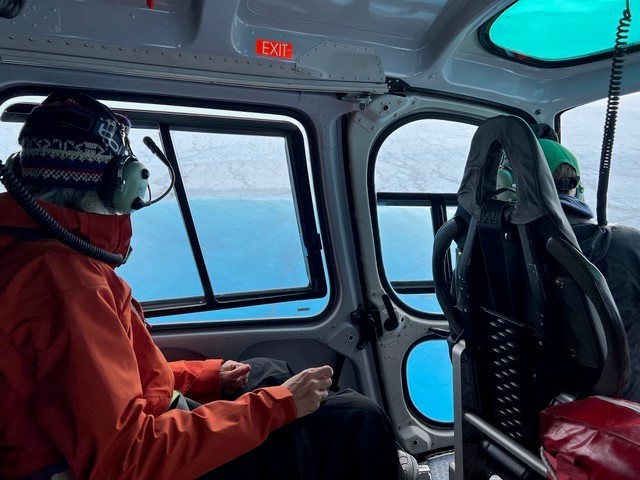Study Upsets Models of How Lake Drainage Within Glaciers May Influence Sea Level
Sudden plunges of lake waters from glacial surfaces to ice-sheet beds may not speed up the movement of Greenland’s tidewater glaciers, as previously thought.

Some models of sea-level rise based on our understanding of how glaciers respond to a warming atmosphere could be incorrect, a new study has found. This could have significant implications for future predictions of global sea level rise from the Greenland and Antarctic ice sheets.
Sea levels are rising as ice on land melts and ocean waters expand. How much and how fast levels will rise in the near future will depend in part on the frequency of glacier calving events—that is, when large chunks of ice from glaciers that terminate in the ocean (known as tidewater glaciers), detach and fall off as icebergs. The faster tidewater glaciers flow toward the ocean, the more ice that calves, and the faster sea level rises.
During the warm summer months, the surface of Greenland’s glaciers can melt and form large lakes that at times drain through to the glacier’s base. Studies on inland glaciers, far from the coast, have shown that this reduces friction between ice and ground, causing the ice to slide faster for a few days. Up to now, however, it has been unclear whether such events affect the speed of tidewater glaciers, and hence the rate of calving events.
To investigate this, a research team from the University of Oxford and the Columbia Climate School’s Lamont-Doherty Earth Observatory used Global Positioning System (GPS) observations of southeastern Greenland’s Helheim Glacier, Greenland’s largest single contributor to sea level rise. They captured a near-perfect natural experiment: high-resolution observations of the glacier’s response over a few days to the sudden drainage of a lake. Normally satellites are used to track glacier speeds, but their temporal resolution is roughly one week, so events like the one captured by GPS usually go unnoticed.
“Nobody had ever observed the response of a major Greenland tidewater glacier to the sudden drainage of a supraglacial lake,” said study coauthor Meredith Nettles, a Lamont-Doherty seismologist.
The researchers found that the Helheim behaved differently from inland ice, which usually sees a fast downhill movement during lake drainage events. In contrast, the Helheim exhibited a relatively small, short pulse of increased movement, and then moved more slowly than usual; in the end there was no net increase in speed.
Using a numerical model of the subglacial drainage system, the researchers surmised that the Helheim likely has an efficient system of channels and cavities along its bed. This allows draining waters to be quickly evacuated without causing an increase in total movement.
Although this appears to be positive news in terms of sea-level-rise implications, the researchers suspect that a different effect may occur for glaciers without an efficient drainage system, where surface melt is currently low but might well increase in the future due to climate change. This appears to be the case in Antarctica.
To investigate this prospect, the team also ran a mathematical model based on the conditions of colder Antarctic tidewater glaciers. The results indicated that lake drainages under these conditions might produce a net increase in glacier movement. This was largely due to a less efficient winter-time subglacial drainage system. As of yet, however, there are no in situ observations of Antarctic tidewater-glacier responses to lake drainage.
“Tidewater glaciers are tricky,” said lead author Laura Stevens of Oxford University. “We have a lot more to learn about how meltwater drainage operates and modulates tidewater-glacier speeds before we can confidently model their future response to atmospheric and oceanic warming.”
The study was also coauthored by James Davis, Timothy Creyts and Jonathan Kingslake of Lamont-Doherty; Ian Hewitt of Oxford; and Aaron Stubblefield of Dartmouth College.
Adapted from a press release by the University of Oxford.
